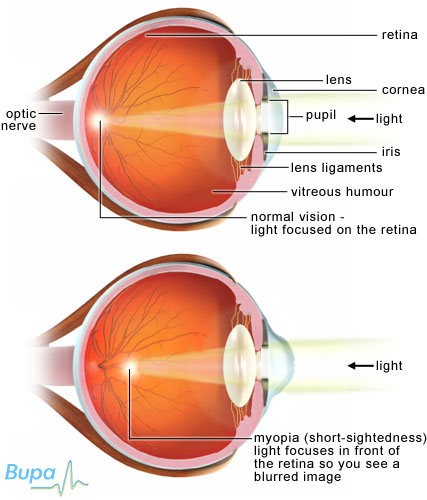Short-sightedness

Short-sightedness is a vision problem which means that people can’t focus on distant objects, making them look blurred.
The medical term for short-sightedness is myopia. Another name for it is near-sightedness.
About short-sightedness
Symptoms of short-sightedness
Causes of short-sightedness
Diagnosis of short-sightedness
Treatment of short-sightedness
About short-sightedness
Normal vision
When you look at something, light rays from the object pass into your eye through your cornea (the clear structure at the front of your eye) then through the lens and on towards the retina at the back of your eye. In a healthy eye the lens and cornea focus the light rays on a small area of your retina so that you can see the object clearly.
What is short-sightedness?
Short-sightedness means you can’t focus on distant objects. This may be because your cornea is too curved or your eyeball is too long, meaning that light rays from distant objects focus in front of your retina. This makes distant objects seem fuzzy or blurred.
Close up objects won't look fuzzy, because the light rays enter your eye at a slight angle. This means they focus on your retina properly.
The diagrams below show normal vision and short-sightedness.

Short-sightedness usually starts in children or young teenagers. It’s very common and tends to run in families.
Symptoms of short-sightedness
Short-sightedness causes distant objects to appear blurry and unfocused, whereas close objects stay in focus.
Young children may not realise they have blurred vision. If your child frowns, squints a lot or has trouble seeing the TV, he or she may have short-sightedness.
Causes of short-sightedness
There are a number of factors that can contribute to short-sightedness.
If your parents are short-sighted, you’re more likely to develop short-sightedness. If one of your parents is short-sighted, there is a one in three chance you will also be short-sighted. If both your parents are short-sighted, there is a one in two chance you will be too.
Babies who are born earlier than usual and who are underweight at birth are more likely to develop short-sightedness.
Researchers have found that the number of people who are short-sighted differs depending on ethnic background. For example, around eight in every 10 people of Asian origin are short-sighted, whereas only three in every 10 people of European origin are.
There is also increasing evidence to show that how you use your eyes when you're a child and young adult can affect your sight in the future. Children and young adults who read a lot or do a lot of close-up work, for example using a computer, may be more likely to develop short-sightedness. Research also shows that people who have jobs that require them to read a lot, for example lawyers and doctors, are more likely to be short-sighted. The reasons behind this aren't fully understood.
Diagnosis of short-sightedness
If you’re straining to see things in the distance, you should visit an optometrist (a registered health professional who examines eyes, tests sight and dispenses glasses and contact lenses) to have your eyes tested.
In order to diagnose short-sightedness, your optometrist will usually ask you to read a standard chart (called a Snellen chart) from a distance of six metres. The chart has large letters at the top and small ones at the bottom.
It's important to have regular eye tests. As well as diagnosing any vision problems, they can reveal other serious illnesses, such as diabetes or high blood pressure. According to the College of Optometrists, you should have an eye test every two years. Depending on your age, and if you have any known sight problems or illnesses that affect your vision, you may need to have more regular eye tests. Ask your optometrist or GP for more advice.
Treatment of short-sightedness
Glasses and contact lenses
Short-sightedness can usually be corrected by you wearing glasses or contact lenses. Your optometrist will discuss with you what options are available.
If you’re mildly short-sighted, you may only need to wear glasses or contact lenses occasionally, such as when you’re driving.
Contact lenses tend to be more expensive than glasses, and you need to be comfortable touching your eyes to use them. You will need to keep them clean and some types require a lot of care. A popular type of contact lenses is daily disposable lenses, which you wear for one day and then throw away. You don’t need to clean or store these lenses.
Glasses are usually recommended for children. They may also be more suitable than contact lenses for older people.
Surgery
- Laser refractive surgery Laser surgery involves small alterations being made to your cornea using a laser, so that light rays are correctly focused onto your retina. To treat short-sightedness, the centre of your cornea is made flatter by removing more tissue from the centre than from the edge.
The procedure is carried out under local anaesthesia, so you’re awake throughout. It only takes a few minutes. The procedure works very well for most people. However, you should be aware that you may not experience the improvement in your eyesight that you expect and you may need further treatment.
There are some risks associated with laser refractive surgery, including infection of your cornea and problems with the flap that is made in your cornea during certain types of laser eye surgery.
If you choose to have laser refractive surgery, it’s important that you consider the benefits and risks of the operation before you go ahead. You should also make sure that it’s carried out by a trained professional.
- Intraocular lens insertion In this operation, a surgeon inserts an artificial lens in front of your own lens. You will be given a local anaesthetic beforehand. The artificial lens allows light rays to focus on your retina rather than in front of it.
This is a new type of treatment and not much is known about the long-term side-effects. It’s not always available and your surgeon will usually only suggest it if you have severe short-sightedness or are unable to wear glasses, for example if you have a disability.
- Radial keratotomy In this operation, several tiny cuts are made in your cornea to flatten it. This is an older treatment and it has largely been replaced by laser-based procedures.
by health professionals, website feedback and requests via email. See our answers to common questions about short-sightedness, including:
Can children have laser eye surgery to correct short-sightedness?
Will I have to pay for an eye test?
What are the risks of wearing contact lenses?
Can children have laser eye surgery to correct short-sightedness?
No, laser eye surgery isn’t suitable for children.
Explanation
Laser eye surgery can be used to correct short sightedness. However, it’s not suitable for people under 21. This is because the eyesight of children and teenagers is constantly changing and your child may become more short-sighted as they get older. If an adult wants to have laser eye surgery, their prescription must have been stable for two to three years.
Will I have to pay for an eye test?
Some people can have a National Health Service (NHS) eye test free of charge. However if you aren’t one of these people you will have to pay for your eye test.
Explantion
Certain people are entitled to a free eye test. You may be entitled to a free eye test if you:
- are aged 60 or over
- are under 16
- are under 19 and in full time education
- live in Scotland
- have diabetes or glaucoma
- are registered blind or partially sighted
- or your partner receive income support, income-based jobseeker’s allowance or pension credit guarantee credit
- are entitled to or named on a valid NHS tax credit exemption certificate, or are named on a valid HC2 certificate
- are entitled to vouchers for complex lenses
- are aged 40 or over and have a close relative with glaucoma
- have been told by an ophthalmologist that you’re at risk of glaucoma.
If you think you qualify for a free eye test, speak to your optometrist for advice before you have your eyes tested.
If you don’t qualify for a free eye test, you will usually need to pay between £17 and £30 for a 20 to 30 minute appointment. Ask your local optometrist how much they charge for an eye test. There may be extra charges for additional tests.
If your doctor has referred you to a hospital for an eye test, this will be free.
What are the risks of wearing contact lenses?
The main risk with wearing contact lenses is an eye infection, but this can be prevented if you look after your lenses and your eyes properly.
Explanation
There are many different types of contact lens available. Some you use daily and then throw away, others you clean each night and use again. It's important to have regular check-ups with your optometrist (a registered health professional who examines eyes, tests sight and dispenses glasses and contact lenses) to make sure that your eyes are healthy and that you're using the best lenses for your needs.
The main risk with contact lenses is infection. If you go to sleep wearing your contact lenses, you have a greater risk of getting an eye infection than if you take them out. Gas permeable lenses and daily disposable lenses have a very low risk of infection. It's important that you care for and store your lenses properly to prevent infection. You can help reduce your risk of getting an eye infection by:
- disinfecting re-usable lenses in between using them – this usually means soaking them in a special solution overnight
- never using the same disinfecting solution twice – always throw it away after you have used it
- rinsing your storage case and leaving it open to dry every day
- using a new storage case every month
- cleaning your storage case once a week using a clean toothbrush and contact lens solution
- not sleeping in your contact lenses unless your optometrist or ophthalmologist has told you to
- always washing your hands before you touch your lenses
- seeing your GP or optometrist immediately if you have red or sore eyes and you think you might have an infection
- only using contact lens solution to clean your lenses (never tap water or saliva)
- not wearing your contact lenses when you go swimming if you aren't wearing goggles
Further information
-
Royal National Institute of Blind People (RNIB)
0845 766 9999
www.rnib.org.uk -
The College of Optometrists
www.college-optometrists.org
Sources
- Myopia – nearsightedness. The Eyecare Trust. www.eyecaretrust.org.uk, accessed 2 February 2010
- Eyesight problems. The College of Optometrists. www.college-optometrists.org, accessed 2 February 2010
- A patients' guide to excimer laser refractive surgery. The Royal College of Ophthalmologists. www.rcophth.ac.uk, published 2 March 2006
- Visually impairing conditions: medical information on myopia. Scottish Sensory Centre. www.ssc.education.ed.ac.uk, accessed 2 February 2010
- 10 reasons for having an eye examination. The College of Optometrists. www.college-optometrists.org, accessed 2 February 2010
- Excimer laser photorefractive surgery – LASIK. The Eyecare Trust. www.eyecaretrust.org.uk, accessed 2 February 2010
- Contact lenses. The Eyecare Trust. www.eyecaretrust.org.uk, accessed 2 February 2010
- Your child’s eyesight. The Eyecare Trust. www.eyecaretrust.org.uk, accessed 2 February 2010
- Photorefractive (laser) surgery for the correction of refractive error. National Institute for Health and Clinical Excellence (NICE), March 2006. www.nice.org.uk
- Correcting refractive errors by inserting an artificial lens near to the natural lens. National Institute for Health and Clinical Excellence (NICE) 2009. www.nice.org.uk
- Barsam A, Allan BDS. Excimer laser refractive surgery versus phakic intraocular lenses for the correction of moderate to high myopia. Cochrane Database of Systematic Reviews 2010, Issue 5. doi: 10.1002/14651858.CD007679.pub2.
Related topics
- Glaucoma
- LASIK (laser-assisted in situ keratomileusis)
- Long-sightedness
- Laser eye surgery (LASIK)
This information was published by Bupa's Health Information Team and is based on reputable sources of medical evidence. It has been peer reviewed by Bupa doctors. The content is intended for general information only and does not replace the need for personal advice from a qualified health professional.
Publication date: May 2010.
















